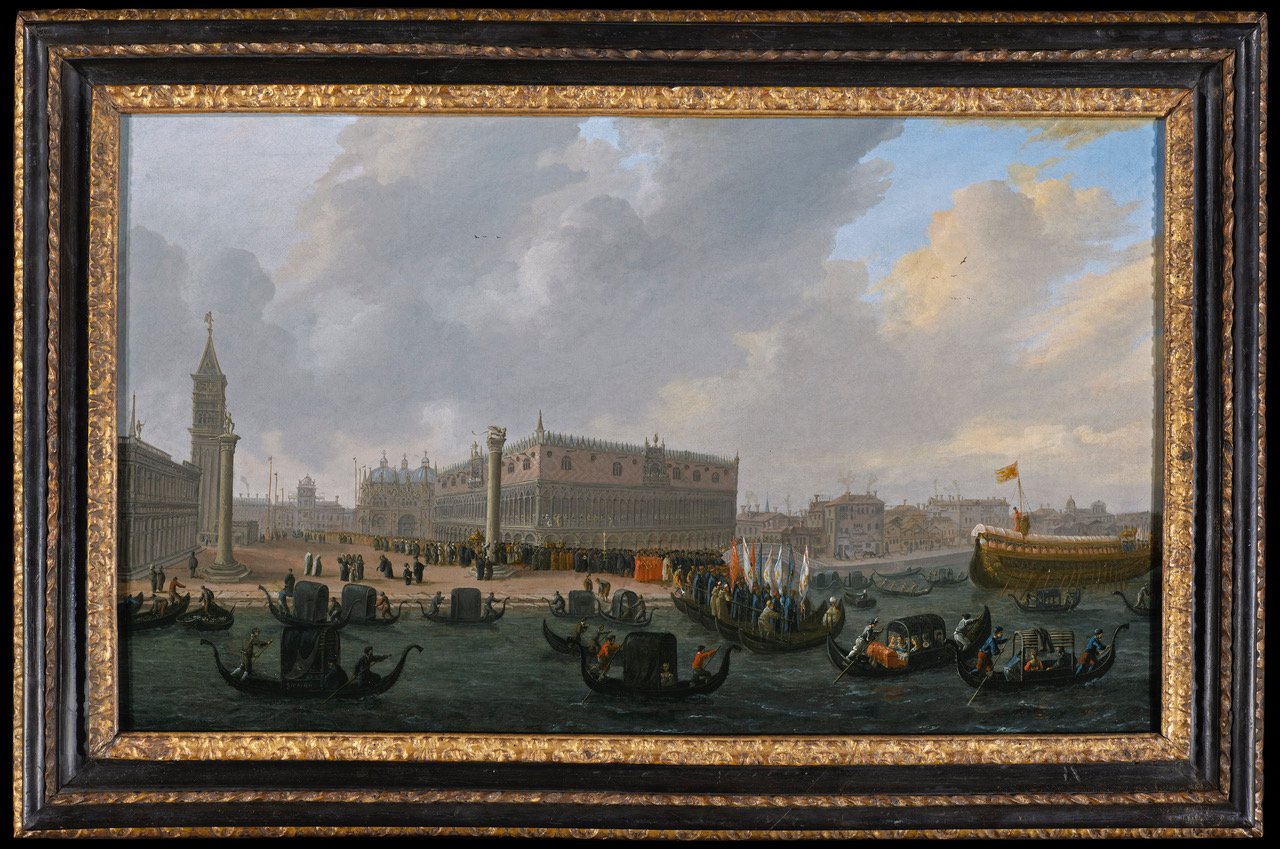REINIER NOOMS, called ZEEMAN
Venice: The Molo from the Bacino di San Marco on Ascension Day
(Amsterdam c. 1623 – 1664)
Oil on canvas - 17 ⅞ x 30 ⅞ inches (45.5 x 78.4 cm)
Signed ‘Zeeman’ (lower left)
PROVENANCE -
Anon. Sale, Sotheby’s, London, 2 February 1927, lot 17, as ‘Zeeman’ (£24 to W. Duits).
Anon. Sale, Drouot, Paris, 19 April 1928, lot 118, as ‘Régnier Zeeman’.
Private Collection, France, until 2015.
LITERATURE -
L. Heiner, ‘Nooms, Reinier’ in The Dictionary of Art, 23, ed. J. Turner, London, 1996, p. 199.
Datable between 1646 and 1655 from the coat-of-arms of Doge Francesco Molin (showing a mill wheel) displayed on the Bucintoro, this is one of the earliest topographically accurate painted views of Venice.
Nooms spent much of his career as a sailor on Dutch merchant vessels, hence the nickname ‘Zeeman’ (Dutch for ‘Seaman’) with which he signs his work.[i] His paintings, which are mostly on canvas, are of three types. Depictions of shipping in calm seas, showing a predominant interest in light and atmosphere, recall those of the slightly younger Willem van de Velde II.[ii] He also painted sea battles, sometimes probably from first-hand experience. The greatest is the huge canvas of The Battle of Leghorn, 1653 (Rijksmuseum, Amsterdam).[iii] Nooms’ representation of ships is predictably accurate, given his first-hand knowledge in this area. His views of places visited on his travels, notably while travelling the major Dutch trading routes to Paris, Italy and the North African coast, are rather different in character but equally precise in their depiction of the topography. They include views of the Louvre (two, dated 165. and 1660 respectively, in the Louvre), Tunis, Salee in Morocco, Tripoli, Syracuse and Algiers (all Rijksmuseum, Amsterdam, the latter of 1662), as well as Dutch cities such as Zaandam and his native Amsterdam (Historisch Museum, Rijksmuseum and Scheepvaart Museum, Amsterdam). There are also a number of depictions of unidentified North African and other Mediterranean coasts.
This unique view of Venice is characteristically accurate in its detail, both of the buildings and mid-seventeenth century gondolas and sandalos, and is an important document of the appearance of the city and its inhabitants in the mid-seventeenth century. With a Dutch sky and clouds, Nooms sees Venice through Dutch eyes more than forty years before Gaspar van Wittel, called Vanvitelli (Amersfoort 1652/3 - Rome 1736), the Dutch-born father of Italian view painting, whose influential visit to Venice is datable to 1694-5.
[i] R. Preston, Seventeenth Century Marine Painters of the Netherlands, Leigh-on-Sea, 1974, records that the signature is occasionally read as ‘Seeman’.
[ii] Leiden 1633 – 1707 Greenwich. Examples are in the Louvre, the Museum Boijmans Van Beuningen, Rotterdam, the Akademie der Bildenden Künste, Vienna (1658;
B. Haak, The Golden Age: Dutch Painters of the Seventeenth Century, London, 1984, fig. 1053), the Berlin Gemäldegalerie and elsewhere (W. Bernt, The Netherlandish Painters of the Seventeenth Century, II, London, 1970, fig. 866).
[iii] W. Stechow, Dutch Landscape Painting of the Seventeenth Century, London, 1966, fig. 249; Heiner, op. cit., illustrated p. 200.


